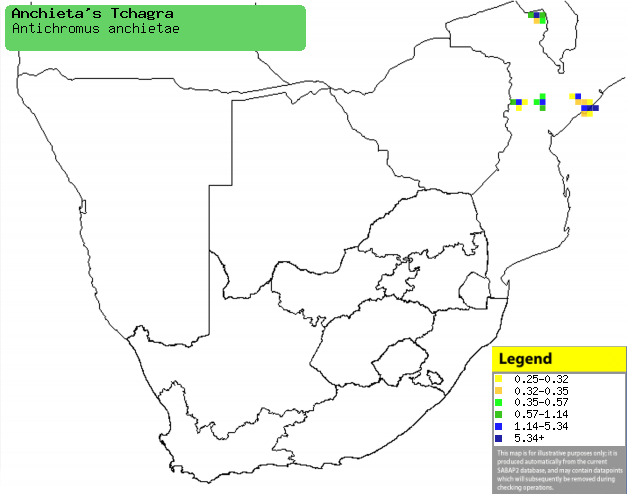|
Antichromus anchietae (Anchieta's
tchagra, Marsh tchagra)
[= Tchagra minuta]
Vleitjagra [Afrikaans]; Kleine tsjagra, Moerastsjagra [Dutch];
Tchagra d'Anchieta [French]; Sumpftschagra [German];
Picanço-assobiador-dos-pântanos [Portuguese]
Life
> Eukaryotes >
Opisthokonta
> Metazoa (animals) >
Bilateria >
Deuterostomia > Chordata >
Craniata > Vertebrata (vertebrates) > Gnathostomata (jawed
vertebrates) > Teleostomi (teleost fish) > Osteichthyes (bony fish) > Class:
Sarcopterygii (lobe-finned
fish) > Stegocephalia (terrestrial
vertebrates) > Tetrapoda
(four-legged vertebrates) > Reptiliomorpha > Amniota >
Reptilia (reptiles) >
Romeriida > Diapsida > Archosauromorpha > Archosauria >
Dinosauria
(dinosaurs) > Saurischia > Theropoda (bipedal predatory dinosaurs) >
Coelurosauria > Maniraptora > Aves
(birds) >
Order: Passeriformes
> Family: Malaconotidae
Distribution and habitat
It has small populations scattered across sub-Saharan
Africa, from Angola and the DRC through to southern Africa. In this region, it only
occurs in a few localities of north-Central Mozambique, extending marginally
into Zimbabwe. It generally prefers humid areas with tall grasses and scattered
bushes, also occurring in reeds or papyrus on the border of streams or swamps.
|
 |
|
Distribution of Anchieta's tchagra in southern Africa,
based on statistical smoothing of the records from first SA Bird Atlas
Project (©
Animal Demography unit, University of
Cape Town; smoothing by Birgit Erni and Francesca Little). Colours range
from dark blue (most common) through to yellow (least common). |
Food
Its diet is exclusively made of mostly large insects,
especially grasshoppers, doing most of its foraging in tall grasses or reedbeds,
occasionally flying to the ground to pick up a prey item.
Breeding
- The nest (see image below) is a sturdily-built deep cup, built of thin
twigs and rootlets bound together with spider web strands, usually lined
with moss, plant detritus and sometimes feathers. It is normally placed in
the fork of a bush's branch, often less then 1 metre above ground.
- It lays 1-3 eggs, which are incubated by both sexes for an unknown period.
Threats
Not threatened.
References
-
Hockey PAR, Dean WRJ and Ryan PG 2005. Roberts
- Birds of southern Africa, VIIth ed. The Trustees of the John Voelcker
Bird Book Fund, Cape Town.
|
